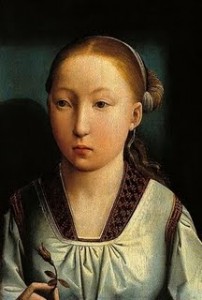
During the night of 15th/16th December 1485, Catherine of Aragon was born at the recently reformed fortified palace at Alcalá de Henares, a town just east of Madrid. Pregnancy had not stopped Catherine’s mother, Isabella I of Castile, from waging war on the Moors, and she had spent the summer of 1485 moving around Andalucia, following her troops’ campaign. Isabella and her troops finished warring for the year in September, and the Royal Court travelled from Andalucia to Alcalá for the winter, and for the impending birth.
Catherine of Aragon, Catalina de Aragón, was the last of Ferdinand II of Aragon and Isabella I’s children, and was named after her maternal great-grandmother, Catalina of Castile or Catherine of Lancaster. Giles Tremlett, in his biography of Catherine, writes of how we know various details about Catherine’s childhood because it was recorded by Gonzalo de Baeza, Isabella’s treasurer. For example, we know that she was baptised by the Bishop of Palencia and wore a a white brocade gown which was trimmed with gold lace and lined with green velvet, and that Dutch olanda linen was used to make her sheets, pillowcases, nightshirts and bibs. We also know that scarlet Florentine cloth was ordered to make clothes, fresh cotton was used to stuff her crib mattress, a brass basin was used for washing her, and that she owned a perfume sprinkler – interesting little insights into the life of a newborn Spanish princess.
When Catherine was just three years-old, it was agreed that she should be betrothed to the heir to the English throne, Prince Arthur. The English ambassadors, Richard Nanfan and Thomas Savage, visited Medina del Campo, in Spain, in March 1489 to meet Ferdinand and Isabella, and to discuss the matter. They saw little Catherine and were obviously happy with what they saw as the Treaty of Medina del Campo, a marriage alliance between England and Spain, was agreed and signed. Catherine was destined to be Queen of England, but not with Arthur at her side – he was to die just a few months after their marriage – but with King Henry VIII, a man known for his six wives and his tyranny.
- Catherine of Aragon – The Boring One?
- Anne Boleyn and Catherine of Aragon Part 1
- Anne Boleyn and Catherine of Aragon Part 2
- Anne Boleyn The Other Woman
- Anne Boleyn the Homewrecker
- The Death of Catherine of Aragon
- RIP Catherine of Aragon
- Did an Eating Disorder Prevent Catherine of Aragon having a Son?
- Catherine Sets Sail for England
- The Coronation of King Henry VIII and Queen Catherine
Notes and Sources
- Catherine of Aragon: Henry’s Spanish Queen, Giles Tremlett